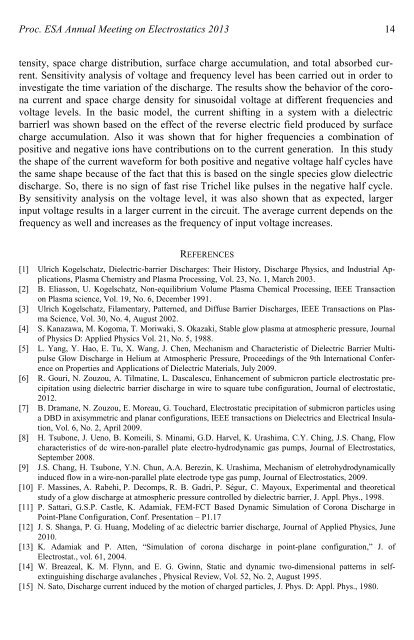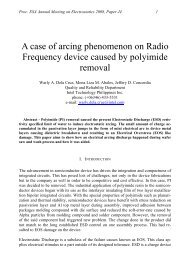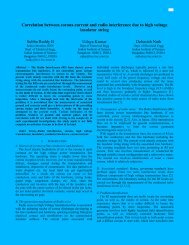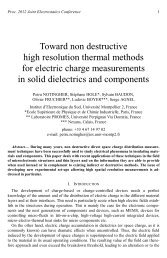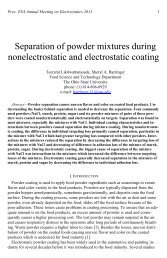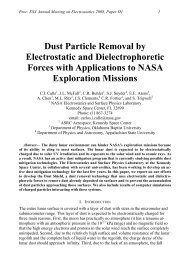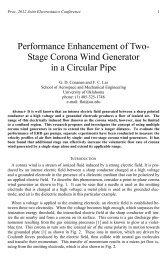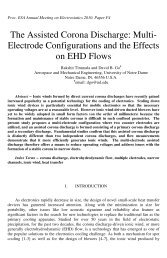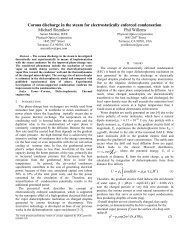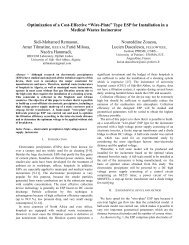Quasi-stationary numerical model of the dielectric barrier discharge
Quasi-stationary numerical model of the dielectric barrier discharge
Quasi-stationary numerical model of the dielectric barrier discharge
Create successful ePaper yourself
Turn your PDF publications into a flip-book with our unique Google optimized e-Paper software.
Proc. ESA Annual Meeting on Electrostatics 2013 14tensity, space charge distribution, surface charge accumulation, and total absorbed current.Sensitivity analysis <strong>of</strong> voltage and frequency level has been carried out in order toinvestigate <strong>the</strong> time variation <strong>of</strong> <strong>the</strong> <strong>discharge</strong>. The results show <strong>the</strong> behavior <strong>of</strong> <strong>the</strong> coronacurrent and space charge density for sinusoidal voltage at different frequencies andvoltage levels. In <strong>the</strong> basic <strong>model</strong>, <strong>the</strong> current shifting in a system with a <strong>dielectric</strong><strong>barrier</strong>l was shown based on <strong>the</strong> effect <strong>of</strong> <strong>the</strong> reverse electric field produced by surfacecharge accumulation. Also it was shown that for higher frequencies a combination <strong>of</strong>positive and negative ions have contributions on to <strong>the</strong> current generation. In this study<strong>the</strong> shape <strong>of</strong> <strong>the</strong> current waveform for both positive and negative voltage half cycles have<strong>the</strong> same shape because <strong>of</strong> <strong>the</strong> fact that this is based on <strong>the</strong> single species glow <strong>dielectric</strong><strong>discharge</strong>. So, <strong>the</strong>re is no sign <strong>of</strong> fast rise Trichel like pulses in <strong>the</strong> negative half cycle.By sensitivity analysis on <strong>the</strong> voltage level, it was also shown that as expected, largerinput voltage results in a larger current in <strong>the</strong> circuit. The average current depends on <strong>the</strong>frequency as well and increases as <strong>the</strong> frequency <strong>of</strong> input voltage increases.REFERENCES[1] Ulrich Kogelschatz, Dielectric-<strong>barrier</strong> Discharges: Their History, Discharge Physics, and Industrial Applications,Plasma Chemistry and Plasma Processing, Vol. 23, No. 1, March 2003.[2] B. Eliasson, U. Kogelschatz, Non-equilibrium Volume Plasma Chemical Processing, IEEE Transactionon Plasma science, Vol. 19, No. 6, December 1991.[3] Ulrich Kogelschatz, Filamentary, Patterned, and Diffuse Barrier Discharges, IEEE Transactions on PlasmaScience, Vol. 30, No. 4, August 2002.[4] S. Kanazawa, M. Kogoma, T. Moriwaki, S. Okazaki, Stable glow plasma at atmospheric pressure, Journal<strong>of</strong> Physics D: Applied Physics Vol. 21, No. 5, 1988.[5] L. Yang, Y. Hao, E. Tu, X. Wang, J. Chen, Mechanism and Characteristic <strong>of</strong> Dielectric Barrier MultipulseGlow Discharge in Helium at Atmospheric Pressure, Proceedings <strong>of</strong> <strong>the</strong> 9th International Conferenceon Properties and Applications <strong>of</strong> Dielectric Materials, July 2009.[6] R. Gouri, N. Zouzou, A. Tilmatine, L. Dascalescu, Enhancement <strong>of</strong> submicron particle electrostatic precipitationusing <strong>dielectric</strong> <strong>barrier</strong> <strong>discharge</strong> in wire to square tube configuration, Journal <strong>of</strong> electrostatic,2012.[7] B. Dramane, N. Zouzou, E. Moreau, G. Touchard, Electrostatic precipitation <strong>of</strong> submicron particles usinga DBD in axisymmetric and planar configurations, IEEE transactions on Dielectrics and Electrical Insulation,Vol. 6, No. 2, April 2009.[8] H. Tsubone, J. Ueno, B. Komeili, S. Minami, G.D. Harvel, K. Urashima, C.Y. Ching, J.S. Chang, Flowcharacteristics <strong>of</strong> dc wire-non-parallel plate electro-hydrodynamic gas pumps, Journal <strong>of</strong> Electrostatics,September 2008.[9] J.S. Chang, H. Tsubone, Y.N. Chun, A.A. Berezin, K. Urashima, Mechanism <strong>of</strong> eletrohydrodynamicallyinduced flow in a wire-non-parallel plate electrode type gas pump, Journal <strong>of</strong> Electrostatics, 2009.[10] F. Massines, A. Rabehi, P. Decomps, R. B. Gadri, P. Ségur, C. Mayoux, Experimental and <strong>the</strong>oreticalstudy <strong>of</strong> a glow <strong>discharge</strong> at atmospheric pressure controlled by <strong>dielectric</strong> <strong>barrier</strong>, J. Appl. Phys., 1998.[11] P. Sattari, G.S.P. Castle, K. Adamiak, FEM-FCT Based Dynamic Simulation <strong>of</strong> Corona Discharge inPoint-Plane Configuration, Conf. Presentation – P1.17[12] J. S. Shanga, P. G. Huang, Modeling <strong>of</strong> ac <strong>dielectric</strong> <strong>barrier</strong> <strong>discharge</strong>, Journal <strong>of</strong> Applied Physics, June2010.[13] K. Adamiak and P. Atten, “Simulation <strong>of</strong> corona <strong>discharge</strong> in point-plane configuration,” J. <strong>of</strong>Electrostat., vol. 61, 2004.[14] W. Breazeal, K. M. Flynn, and E. G. Gwinn, Static and dynamic two-dimensional patterns in selfextinguishing<strong>discharge</strong> avalanches , Physical Review, Vol. 52, No. 2, August 1995.[15] N. Sato, Discharge current induced by <strong>the</strong> motion <strong>of</strong> charged particles, J. Phys. D: Appl. Phys., 1980.


